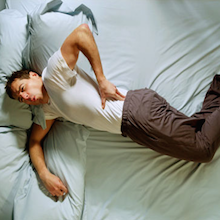One of the most common injuries of any athlete I see in the clinic are strains and minor tears to the hamstrings. Years ago it was common practice to stretch them statically (without movement) before any type of exercises such as lifting or an athletic event. In recent years there have been numerous research articles that demonstrate static hamstring stretching actually decreases athletic performance. The articles present the new train of thought, which is to perform dynamic stretches before athletic events to decrease the risk of injury. Many studies have shown this to be more beneficial than static stretching but the injuries are still occurring! Through clinical practice and my own personal experience, I question if the problem causing the hamstring strain is not actually being caused by the hamstring tightness?
It is easy to think the cause of a muscle injury is due to it being overly tight. When something is excessively tight it is going to be easier to tear, right? For example, if you have a rubber band it will tear more quickly if it is already put on a stretch, right? Instead of being so quick to assume tightness and only stretch the hamstrings why aren’t we looking to see the source of why the hamstrings are tight in the first place. During my schooling, one of the best pieces of advice I received from an instructor was “there is always a reason for tightness.” In our bodies, tight muscles don’t spontaneously become tight, but instead, the body is constantly adapting to our environment resulting in that tightness. There can be numerous different reason with every muscle, but with the hamstrings, I have found there are two very common reasons: instability in the hip/spine and poor strength ratio between quad and hamstrings.
To understand these causes we need to understand how the hamstrings work during activities such as running and walking. It would be easy to think that the primary role hamstrings serve during weight bearing activity, such as running, is propulsion forward by actively bending the knee. This seems logical because if you isolate your hamstrings and contract them you will bend your knee, so it seems logical that this should be its job during walking or running. This is not the case. You actually require very little hamstring activation to bend your knee and the majority of your knee bend during running actually comes from stretch-reflex generated during hip extension. Recent research suggests that you may contract as little as 7% of your hamstrings to cause this knee bend. So if they don’t have a major role in bending the knee what do they do? First, they assist in slowing your knee extension right before your leg contacts the ground (Terminal Swing Phase). This is called an eccentric contraction. An eccentric muscle contraction is when the muscle contracts while the muscle lengthens as if you are lowering a weight. A concentric muscle contraction is when the muscle contracts while it shortens, as in a normal bicep curl. An important fact is that eccentric contractions recruit more muscle fibers than a concentric contraction.
The Terminal Swing phase of the running cycle is where the first problem resulting in hamstring injury can stem from. During this phase, you have the quad fighting against the hamstring. As I said before the hamstring is eccentrically contracting to slow knee extension but at the same time, you have the quad concentrically contracting to fully extend the knee. This is the point the quad/hamstring strength ratio becomes very important. With most athletes, their quads are very strong because they are inherently very easy to strengthen. Conversely, the hamstrings tend to be much weaker because they usually aren’t the center of focus when it comes to strengthening. Keeping in mind an eccentric muscle contraction places much more demand on a muscle than a concentric contraction. So the quad and hamstrings are both contracting during this phase and if the quad is much stronger it will cause added tension onto the hamstrings, making it more susceptible to injury. In this case, the body will naturally increase tension in the hamstring to help compensate for the lack of strength in it, thus creating “tight” hamstrings. In this instance, instead of stretching the hamstrings so frequently, the better solution would be some hamstring strengthening to help fix the root of the problem. Recent studies with long distances runners have suggested to improve the economy of running you want a 1:1 ratio of hamstring:quad strength. Also in studies of female soccer players the closer players were to a 1:1 ratio the less susceptible they were to injury.
The second common problem occurs in the next phase of running, which is Stance Phase. As said previously the common belief for the job of the hamstrings during this phase would be to pull the leg back, providing propulsion, which again is not true. Yes, the hamstrings can function as a hip extensor (pulling the leg back) but it is very inefficient at this job. This is because the hamstrings muscle attachments cross two joints, the hip, and knee. Since the hamstrings cross two joints it makes them a very poor hip extensor. So our body is designed to get this hip extension primarily from our glut muscles which only cross one joint, the hip, making them better designed to handle this load. In stance phase, our hamstrings are actually designed not to create movement but to maintain tone and prevent movement. This creates rigidity at the knee joint and helps support the hip joint. This is where the second common injury comes in play. As just explained the chief hip extensors are the glut muscles, so if the glut muscles have weakness or fatigue they are going to need some assistance to create propulsion. So the next hip extensor muscle needs to assist, which is the hamstrings. Therefore in addition to maintaining rigidity, hip extension is added to the hamstrings work load, keeping in mind this muscle group is very poor at hip extension. The combination of extension and maintenance of rigidity results in an extreme work load placed on the hamstrings. Any time you create a workload on a body part that it is not meant to handle, it increases the risk of injury. The body adapts by increasing muscle tension to compensate for the overload of the hamstrings, decreasing the flexibility. The solution to this instance of “tightness”, would be working on glute activation and strengthening to decrease the risk of developing hamstring injury.
The main point here is to try not to focus so much on stretching your hamstrings to prevent injury, but rather try observing other parts of the body to find the source. Try looking at the balance between the hamstring and quad strength or look for weakness in your glute muscles. These are the two common reasons I have seen for a hamstring injury, but that does not mean they are the only causes of a hamstring injury. I suggest you and your team look at all sources to help prevent hamstrings injuries from occurring.



